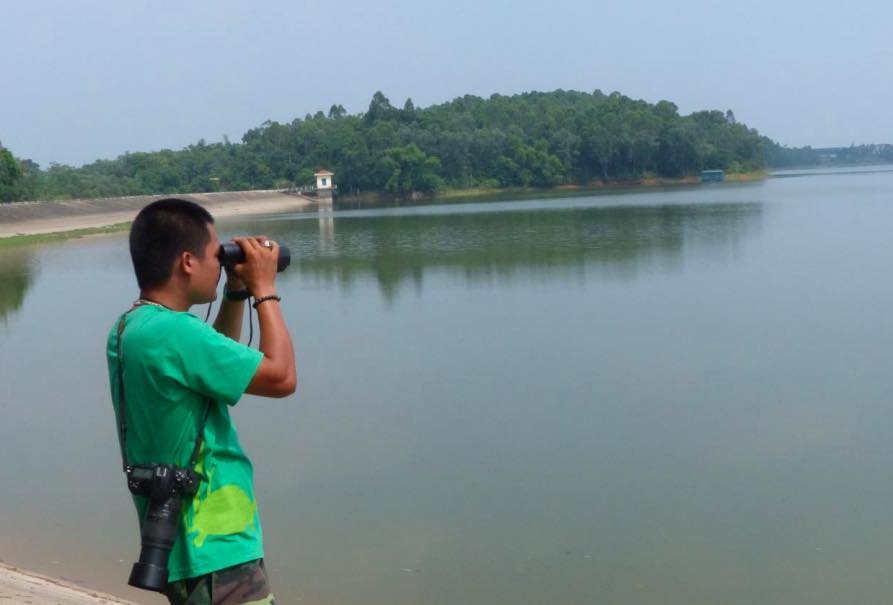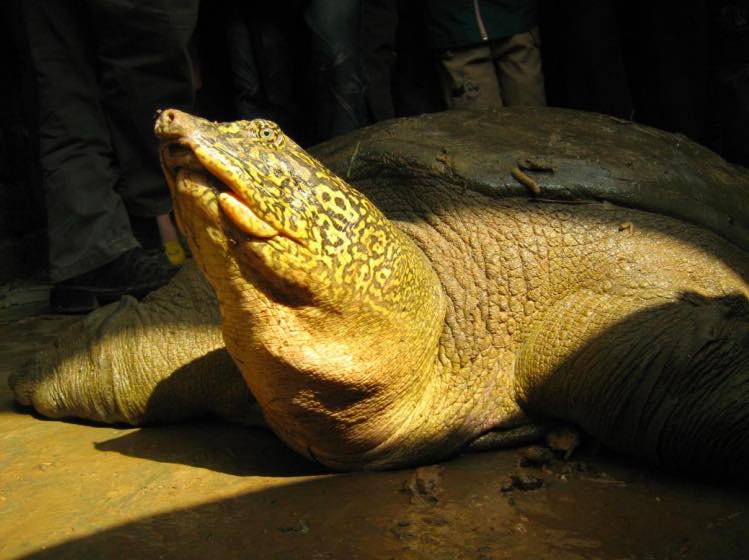- Some experts have now confirmed the presence of a Yangtze giant softshell turtle in Vietnam, increasing the total known population of the turtle to four individuals.
- Researchers matched environmental DNA collected from water samples from Xuan Khanh Lake in Vietnam to known samples from the species, and confirmed that the giant turtle living in the lake was most likely the Yangtze giant softshell turtle.
- Threats remain for the recently identified Yangtze giant softshell turtle. Xuan Khanh Lake is not protected, and commercial fishing is allowed there.
When Cu Rua, an old Yangtze giant softshell turtle, died in Vietnam in 2016, he left behind only three of his kind: an elderly pair in a Chinese zoo, and a wild individual in a Vietnamese lake called Dong Mo. This meant that the Yangtze giant softshell turtle (Rafetus swinhoei), one of the world’s largest known freshwater turtle species, also became one of the world’s rarest.
Now, some turtle experts are confident they’ve identified a fourth specimen of this critically endangered turtle in Vietnam’s Xuan Khanh lake.
“It’s a good feeling to confirm the presence of a fourth turtle; it gives us hope something can be done to bring the species back,” Timothy McCormack, program coordinator of the Hanoi-based Asian Turtle Program of Indo-Myanmar Conservation (ATP/IMC), a U.K.-based conservation charity, told Mongabay. “I’ve put a lot of time into looking for this species and have always believed it has a chance.”

But this confirmation comes after a long and winding journey.
Reports of a plausible giant softshell turtle in Xuan Khanh Lake first surfaced in 2012 in the form of a photograph, McCormack said. The image wasn’t sufficiently clear to confirm the species, though, and intensive surveys of the lake over subsequent years failed to confirm the turtle’s presence.
Then, in May 2017, Nguyen Van Trong, a former fisherman who now works with ATP/IMC, photographed what looked like a giant softshell turtle. Again, the blurry photograph wasn’t enough to confirm the species. So the team partnered with Caren Goldberg, an ecologist at Washington State University, U.S., to see if they could identify the species using environmental DNA (eDNA) — tiny DNA fragments that animals leave behind in the environment when they lose cells, such as by shedding skin or excreting waste.
Goldberg’s team matched eDNA collected from water samples of Xuan Khanh Lake to known samples of the species, suggesting that there was indeed a Yangtze giant softshell turtle living in the lake.
“It is difficult to detect a species at very low densities with eDNA, the sample has to be collected fairly close to where the animal is or was very recently,” Goldberg told Mongabay. “We analyzed many samples testing negative in addition to this positive sample. Between the visual observations and the sequence from the eDNA sample, there is a good amount of evidence that this turtle is another Rafetus swinhoei.”
McCormack said they held back on announcing the turtle’s identity until after Goldberg’s team came back with reliable results.
“We didn’t feel the photo in itself [taken in May 2017] was clear enough. Although the animal’s the right shape and a good size, it just wasn’t identifiable,” he said. “Caren did get some initial weak positives for Rafetus but again we have held off on making an announcement until just a few weeks ago she was able to improve the sensitivity. Of course there is still the slim chance that another closely related species could be misidentified or that genetic information on gene bank is not accurate. But we are confident enough to go public with this.”

The Yangtze giant softshell turtle, also called the Red River giant softshell turtle, Shanghai softshell turtle or Swinhoe’s softshell turtle, was once known from the Red River in China and Vietnam and from China’s lower Yangtze River floodplain, according to the Turtle Conservation Coalition that recently released a report on the world’s 50 most threatened turtles. The loss of wetland habitats from river damming and infrastructure development, as well poaching for meat and eggs and capture for the pet trade, has reduced the species’ population to just the four known specimens now.
There may be more individuals in the wild, though, and Goldberg is hopeful that others can potentially be located with the help of eDNA.
McCormack agrees. “The species is very secretive and the lakes and large rivers that they are found in [are] large and complex,” he said. “If you see how difficult it is to observe these animals, even when you know they are in a relatively small area then you’ll understand how hard they will be [to] find. This is why we have tried methods such as eDNA and sonar fish finders in the search for surviving individuals.”
The team has prepared a list of other sites where the species historically occurred, where there have been recent accounts of sightings.
“These are the next places to look,” McCormack said.

Threats remain for the recently identified Yangtze giant softshell turtle. Xuan Khanh does not lie within any protected area, and commercial fishing is allowed there. “But the lake owner hires a security team and we have a staff member who monitors the lake,” McCormack said. He added that confirmation of the animal’s identity will hopefully mean more attention is paid to protect the animal.
“If the fishing teams should catch the animal this week, accidentally or otherwise, we’d expect a rapid response from the authorities,” he said. “During high risk activities, such as fish harvests our team is also full time on the lake. Really we need more staff, as is often the case in conservation [the] funds are limited.”
McCormack added that in Dong Mo Lake, where the only other wild individual is known to occur, the lake owner has been very cooperative. The fishermen using the lake have also signed no-hunting agreements, and McCormack’s team has been raising community support for the protection of the species.
“Long term, we’d like to see the [Xuan Khanh] animal moved to Dong Mo Lake where we have an island with a large pond identified that would function as a semi-wild area,” he said. “This could be used to bring the two animals so far identified in Vietnam together, if male and female, for breeding.
“It would also provide much easier security for the animals,” he added. “Opportunistic hunting in Xuan Khanh and Dong Mo are still very real threats: we’ve had two very close calls that we know of in the past decade for the Dong Mo turtle. In the future we hope the Vietnamese authorities take more responsibility for protection of this species.”
